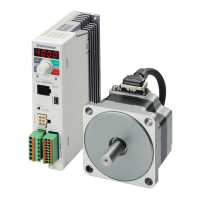Connection
−
29
−
7.6 Selecting the I/O signal power supply
Select the I/O signal power supply (built-in
power supply or external power supply) to be
used.
The driver comes with a built-in power supply.
To control the operation using relays and
switches, set the external voltage selector
switch SW2-1 to the ON side to select the
built-in power supply.
Factory setting:
OFF (an external power supply is used)
SW2-1
External voltage selection switch
ON: Using the built-in
power supply
OFF: Using an external
power supply
Note
•
Change the setting of the external voltage selector switch SW2-1 before turning on the power.
•
The built-in power supply cannot be used with the source logic. If the source logic is used, do
not turn the external voltage selector switch to the ON position.
7.7 Connecting the I/O signals
Connector function table
Pin No.
Terminal
name
Signal name Name Explanation
1 C0 IN-COM0 Input signal common −
2 X0
*
FWD Forward input The motor turns in the clockwise direction.
3 X1
*
REV Reverse input The motor turns in the counterclockwise direction.
4 X2
*
STOP-MODE
Stop mode selection
input
Select instantaneous stop or deceleration stop.
5 X3
*
M0
Speed setting selection
input
Select the internal potentiometer or external
potentiometer (external DC voltage).
6 X4
*
ALARM-RESET Alarm reset input Alarms are reset.
7 X5
*
MB-FREE
Electromagnetic brake
release input
Select the operation mode of the electromagnetic
brake when the motor stops. This signal is not
used for the standard type.
8 X6
*
TH
Regeneration resistor
thermal input
If a regeneration unit is used, connect the
thermostat output of the regeneration unit (normally
closed).
9 VH VH
External speed setting
input
Set the speed of the external potentiometer
(external DC voltage). Refer to p.39 for details.
10 VM VM
11 VL VL
12 C1 IN-COM1 Input common (0 V) −
13 Y0+
*
SPEED-OUT (+)
SPEED-OUT output
30 pulses are output with each revolution of the
motor output shaft. (To use this signal in the
FBL
Ⅱ
compatible mode, refer to p.44.)
14 Y0−
*
SPEED-OUT (−)
15 Y1+
*
ALARM-OUT1 (+)
ALARM-OUT1 output
This signal is output when an alarm generates
(normally closed).
16 Y1−
*
ALARM-OUT1 (−)
*
The
OPX-2A
or
MEXE02
can be used to change the assignments of I/O signals. Refer to p.47.

